Associations between Respiratory Health Outcomes and Coal Mine Fire PM2.5 Smoke Exposure: A Cross-Sectional Study
Abstract
1. Introduction
2. Materials and Methods
2.1. Study Design and Setting
2.2. Participants
2.3. Variables
2.4. Statistical Methods
2.5. Ethics Approval
3. Results
4. Discussion
Strengths and Limitations
5. Conclusions
Supplementary Materials
Author Contributions
Funding
Acknowledgments
Conflicts of Interest
References
- Reisen, F.; Gillett, R.; Choi, J.; Fisher, G.; Torre, P. Characteristics of an open-cut coal mine fire pollution event. Atmos. Environ. 2017, 151, 140–151. [Google Scholar] [CrossRef]
- Stracher, G.B.; Taylor, T.P. Coal fires burning out of control around the world: Thermodynamic recipe for environmental catastrophe. Int. J. Coal Geol. 2004, 59, 7–17. [Google Scholar] [CrossRef]
- Fisher, G.W.; Torre, P.; Marshall, A. Hazelwood open-cut coal mine fire. Air Qual. Clim. Change 2015, 49, 23–27. [Google Scholar]
- Youssouf, H.; Liousse, C.; Roblou, L.; Assamoi, E.M.; Salonen, R.O.; Maesano, C.; Banerjee, S.; Annesi-Maesano, I. Quantifying wildfires exposure for investigating health-related effects. Atmos. Environ. 2014, 97, 239–251. [Google Scholar] [CrossRef]
- Ellyett, C.D.; Fleming, A.W. Thermal infrared imagery of The Burning Mountain coal fire. Remote Sens. Environ. 1974, 3, 79–86. [Google Scholar] [CrossRef]
- Saini, V.; Gupta, R.P.; Arora, M.K. Environmental impact studies in coalfields in India: A case study from Jharia coal-field. Renew. Sustain. Energy Rev. 2016, 53, 1222–1239. [Google Scholar] [CrossRef]
- Melody, S.M.; Johnston, F.H. Coal mine fires and human health: What do we know? Int. J. Coal Geol. 2015, 152, 1–14. [Google Scholar] [CrossRef]
- Emmerson, K.; Reisen, F.; Luhar, A.; Williamson, G.; Cope, M.; Air Quality Modelling of Smoke Exposure from the Hazelwood Mine Fire. Commonwealth Scientific and Industrial Research Organisation: Australia. 2016. Available online: https://publications.csiro.au/rpr/pub?pid=csiro:EP167999 (accessed on 30 June 2018).
- Dennekamp, M.; Abramson, M.J. The effects of bushfire smoke on respiratory health. Respirology 2011, 16, 198–209. [Google Scholar] [CrossRef]
- Haikerwal, A.; Akram, M.; Sim, M.R.; Meyer, M.; Abramson, M.J.; Dennekamp, M. Fine particulate matter (PM2.5) exposure during a prolonged wildfire period and emergency department visits for asthma. Respirology 2016, 21, 88–94. [Google Scholar] [CrossRef]
- Delfino, R.J.; Brummel, S.; Wu, J.; Stern, H.; Ostro, B.; Lipsett, M.; Winer, A.; Street, D.H.; Zhang, L.; Tjoa, T.; et al. The relationship of respiratory and cardiovascular hospital admissions to the southern California wildfires of 2003. Occup. Environ. Med. 2009, 66, 189–197. [Google Scholar] [CrossRef] [PubMed]
- Cascio, W.E. Wildland fire smoke and human health. Sci. Total Environ. 2018, 624, 586–595. [Google Scholar] [CrossRef] [PubMed]
- Youssouf, H.; Liousse, C.; Roblou, L.; Assamoi, E.M.; Salonen, R.O.; Maesano, C.; Banerjee, S.; Annesi-Maesano, I. Non-accidental health impacts of wildfire smoke. Int. J. Environ. Res. Public Health 2014, 11, 11772–11804. [Google Scholar] [CrossRef] [PubMed]
- Reid, C.E.; Brauer, M.; Johnston, F.; Jerrett, M.; Balmes, J.R.; Elliott, C.T. Critical Review of Health Impacts of Wildfire Smoke Exposure. Environ. Health Perspect. 2016, 124, 9. [Google Scholar] [CrossRef] [PubMed]
- Liu, J.C.; Pereira, G.; Uhl, S.A.; Bravo, M.A.; Bell, M.L. A systematic review of the physical health impacts from non-occupational exposure to wildfire smoke. Environ. Res. 2015, 136, 120–132. [Google Scholar] [CrossRef] [PubMed]
- Johnson, A.L.; Dipnall, J.F.; Dennekamp, M.; Williamson, G.J.; Gao, C.X.; Carroll, M.T.C.; Dimitriadis, C.; Ikin, J.F.; Johnston, F.H.; McFarlane, A.C.; et al. Fine particulate matter exposure and medication dispensing during and after a coal mine fire: A time series analysis from the Hazelwood Health Study. Environ. Pollut. 2019, 246, 1027–1035. [Google Scholar] [CrossRef]
- Hendryx, M. The public health impacts of surface coal mining. Extr. Ind. Soc. 2015, 2, 820–826. [Google Scholar] [CrossRef]
- Department of the Environment and Energy, National Air Quality Standards, in National Air Quality Standards. Commonwealth of Australia: Australia. 2016. Available online: http://www.environment.gov.au/protection/publications/factsheet-national-standards-criteria-air-pollutants-australia (accessed on 15 January 2018).
- Abramson, M.; Blackman, J.; Brown, D.; Campbell, T.; Carroll, M.; Dimitriadis, C.; Del Monaco, A.; Denny, S.; Gao, C.; Guo, Y.; et al. Hazelwood Health Study Adult Survey. In The Relationship Between Hazelwood Mine Fire Smoke Exposure and Health Outcomes; Monash University: Clayton VIC, Australia, 2018; Volume 2, p. 22. Available online: www.hazelwoodhealthstudy.org.au/study-findings/study-reports/ (accessed on 19 February 2019).
- Abramson, M.; Blackman, J.; Carroll, M.; Dimitriadis, C.; Del Monaco, A.; Dennekamp, M.; Denny, S.; Gao, C.; Liew, D.; Maybery, D.; et al. Hazelwood Health Study Adult Survey. In Comparison of Morwell and Sale; Monash University: Clayton VIC, Australia, 2017; Volume 1, p. 22. Available online: www.hazelwoodhealthstudy.org.au/study-findings/study-reports/ (accessed on 19 February 2019).
- Australian Bureau of Statistics. Australian Statistical Geography Standard (ASGS): Volume 1—Main Structure and Greater Capital City Statistical Areas; ABS: Canberra, Australia, 2016. Available online: http://www.abs.gov.au/ausstats/abs@.nsf/Lookup/by%20Subject/1270.0.55.001~July%202016~Main%20Features~Overview~1 (accessed on 30 May 2017).
- Burney, P.G.; Luczynska, C.; Chinn, S.; Jarvis, D. The European Community Respiratory Health Survey. Eur. Respir. J. 1994, 7, 954. [Google Scholar] [CrossRef]
- WHO. Guidelines for Controlling and Monitoring the Tobacco Epidemic. 1998. Available online: https://apps.who.int/iris/bitstream/handle/10665/42049/9241545089-eng.pdf (accessed on 13 June 2019).
- Hurley, P. The air pollution model (TAPM) Version 3. Part 1, Technical description. In CSIRO Atmospheric Research Technical Paper; CSIRO Marine & Atmospheric Research: Aspendale, VIC, Australia, 2005; p. 54. [Google Scholar] [CrossRef]
- Hurley, P.J.; Edwards, M.C.; Luhar, A.K. TAPM V4. Part 2—Summary of some verification studies. In CSIRO Marine and Atmospheric Research; CSIRO Marine & Atmospheric Research: Aspendale, VIC, Australia, 2008; p. 31. Available online: https://www.cmar.csiro.au/research/tapm/docs/tapm_v4_technical_paper_part2.pdf (accessed on 30 November 2017).
- McGregor, J.L.; Dix, M.R. An updated description of the conformal-cubic atmospheric model. In High Resolution Numerical Modelling of the Atmosphere and Ocean; Springer: New Yrk, NY, USA, 2008; pp. 51–75. [Google Scholar]
- Noble, I.R.; Gill, A.M.; Bary, G.A.V. McArthur’s fire-danger meters expressed as equations. Aust. J. Ecol. 1980, 5, 201–203. [Google Scholar] [CrossRef]
- Rubin, D.B. Multiple imputation after 18+ years. J. Am. Stat. Assoc. 1996, 91, 473. [Google Scholar] [CrossRef]
- Royston, P.; White, I. Multiple Imputation by Chained Equations (MICE): Implementation in Stata. J. Stat. Softw. 2011, 45, 1–20. [Google Scholar] [CrossRef]
- StataCorp. Stata Statistical Software: Release 15; StataCorp LLC: College Station, TX, USA, 2017. [Google Scholar]
- Künzli, N.; Avol, E.; Wu, J.; Gauderman, W.J.; Rappaport, E.; Millstein, J.; Bennion, J.; McConnell, R.; Gilliland, F.D.; Berhane, K.; et al. Health Effects of the 2003 Southern California Wildfires on Children. Am. J. Respir. Crit. Care Med. 2006, 174, 1221–1228. [Google Scholar] [CrossRef] [PubMed]
- Henderson, S.B.; Brauer, M.; MacNab, Y.C.; Kennedy, S.M. Three measures of forest fire smoke exposure and their associations with respiratory and cardiovascular health outcomes in a population-based cohort. Environ. Health Perspect. 2011, 119, 1266–1271. [Google Scholar] [CrossRef] [PubMed]
- Yao, J.; Brauer, M.; Henderson, S.B. Evaluation of a wildfire smoke forecasting system as a tool for public health protection. Environ. Health Perspect. 2013, 121, 1142–1147. [Google Scholar] [CrossRef] [PubMed]
- Yuchi, W.; Yao, J.; McLean, K.E.; Stull, R.; Pavlovic, R.; Davignon, D.; Moran, M.D.; Henderson, S.B. Blending forest fire smoke forecasts with observed data can improve their utility for public health applications. Atmos. Environ. 2016, 145, 308–317. [Google Scholar] [CrossRef]
- Elliott, C.T.; Henderson, S.B.; Wan, V. Time series analysis of fine particulate matter and asthma reliever dispensations in populations affected by forest fires. Environ. Health Glob.Access Sci. Sour. 2013, 12, 9. [Google Scholar] [CrossRef]
- Delgado-Rodriguez, M.; Llorca, J. Bias. J. Epidemiol. Community Health 2004, 58, 635. [Google Scholar] [CrossRef]
- Alman, B.L.; Pfister, G.; Hao, H.; Stowell, J.; Hu, X.; Liu, Y.; Strickland, M.J. The association of wildfire smoke with respiratory and cardiovascular emergency department visits in Colorado in 2012: A case crossover study. Environ. Health 2016, 15, 64. [Google Scholar] [CrossRef]
- Tinling, M.A.; West, J.J.; Cascio, W.E.; Kilaru, V.; Rappold, A.G. Repeating cardiopulmonary health effects in rural North Carolina population during a second large peat wildfire. Environ. Health 2016, 15, 12. [Google Scholar] [CrossRef]
- Long, C.M.; Suh, H.H.; Catalano, P.J.; Koutrakis, P. Using Time- and Size-Resolved Particulate Data To Quantify Indoor Penetration and Deposition Behavior. Environ. Sci. Technol. 2001, 35, 2089–2099. [Google Scholar] [CrossRef]
- Henderson, D.E.; Milford, J.B.; Miller, S.L. Prescribed Burns and Wildfires in Colorado: Impacts of Mitigation Measures on Indoor Air Particulate Matter. J. Air Waste Manag. Assoc. 2005, 55, 1516–1526. [Google Scholar] [CrossRef]
- Allen, R.W.; Carlsten, C.; Karlen, B.; Leckie, S.; Eeden Sv Vedal, S.; Wong, I.; Brauer, M. An Air Filter Intervention Study of Endothelial Function among Healthy Adults in a Woodsmoke-impacted Community. Am. J. Respir. Crit. Care Med. 2011, 183, 1222–1230. [Google Scholar] [CrossRef] [PubMed]
- Rappold, A.G.; Reyes, J.; Pouliot, G.; Cascio, W.E.; Diaz-Sanchez, D. Community Vulnerability to Health Impacts of Wildland Fire Smoke Exposure. Environ. Sci. Technol. 2017, 51, 6674–6682. [Google Scholar] [CrossRef] [PubMed]
- Australian Bureau of Statistics. 4364.0.55.001—National Health Survey: First Results, 2017-18 2018 12 December 2018. Available online: https://www.abs.gov.au/ausstats/abs@.nsf/Lookup/by%20Subject/4364.0.55.001~2017-18~Main%20Features~Asthma~35 (accessed on 9 October 2019).
- Hendryx, M.; Luo, J. An examination of the effects of mountaintop removal coal mining on respiratory symptoms and COPD using propensity scores. Int. J. Environ. Health Res. 2015, 25, 265–276. [Google Scholar] [CrossRef] [PubMed]
- Chang, E.T.; Adami, H.O.; Bailey, W.H.; Boffetta, P.; Krieger, R.I.; Moolgavkar, S.H.; Mandel, J.S. Validity of geographically modeled environmental exposure estimates. Crit. Rev. Toxicol. 2014, 44, 450–466. [Google Scholar] [CrossRef]
- Michopoulos, V.; Jovanovic, T. Chronic inflammation: A new therapeutic target for post-traumatic stress disorder? Lancet Psychiatry 2015, 2, 954–955. [Google Scholar] [CrossRef]
- Li, J.; Brackbill, R.M.; Jordan, H.T.; Cone, J.E.; Farfel, M.R.; Stellman, S.D. Effect of asthma and PTSD on persistence and onset of gastroesophageal reflux symptoms among adults exposed to the September 11, 2001, terrorist attacks. Am. J. Ind. Med. 2016, 59, 805–814. [Google Scholar] [CrossRef]
- Gan, W.Q.; Man, S.F.P.; Senthilselvan, A.; Sin, D.D. Association between chronic obstructive pulmonary disease and systemic inflammation: A systematic review and a meta-analysis. Thorax 2004, 59, 574–580. [Google Scholar] [CrossRef]
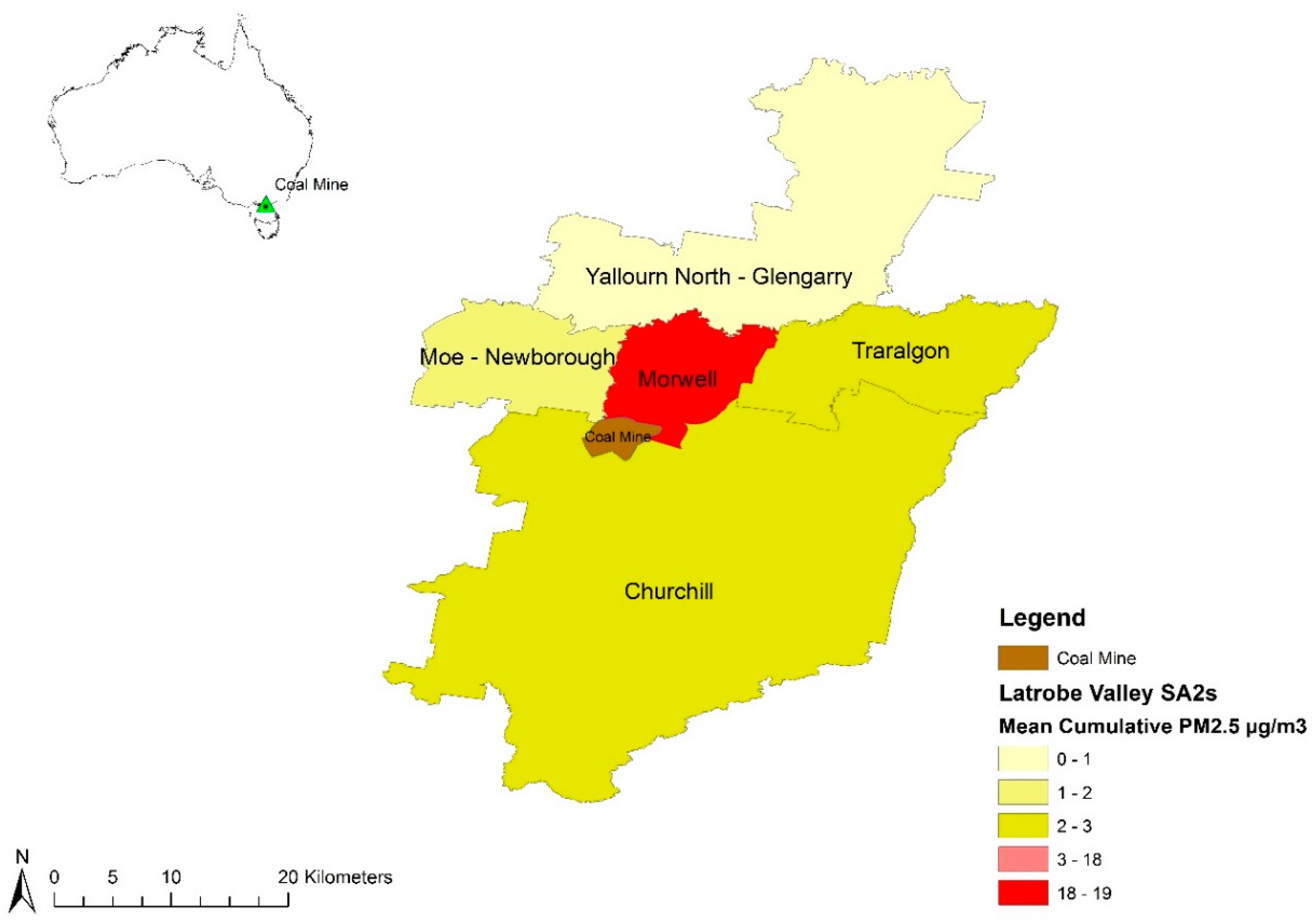
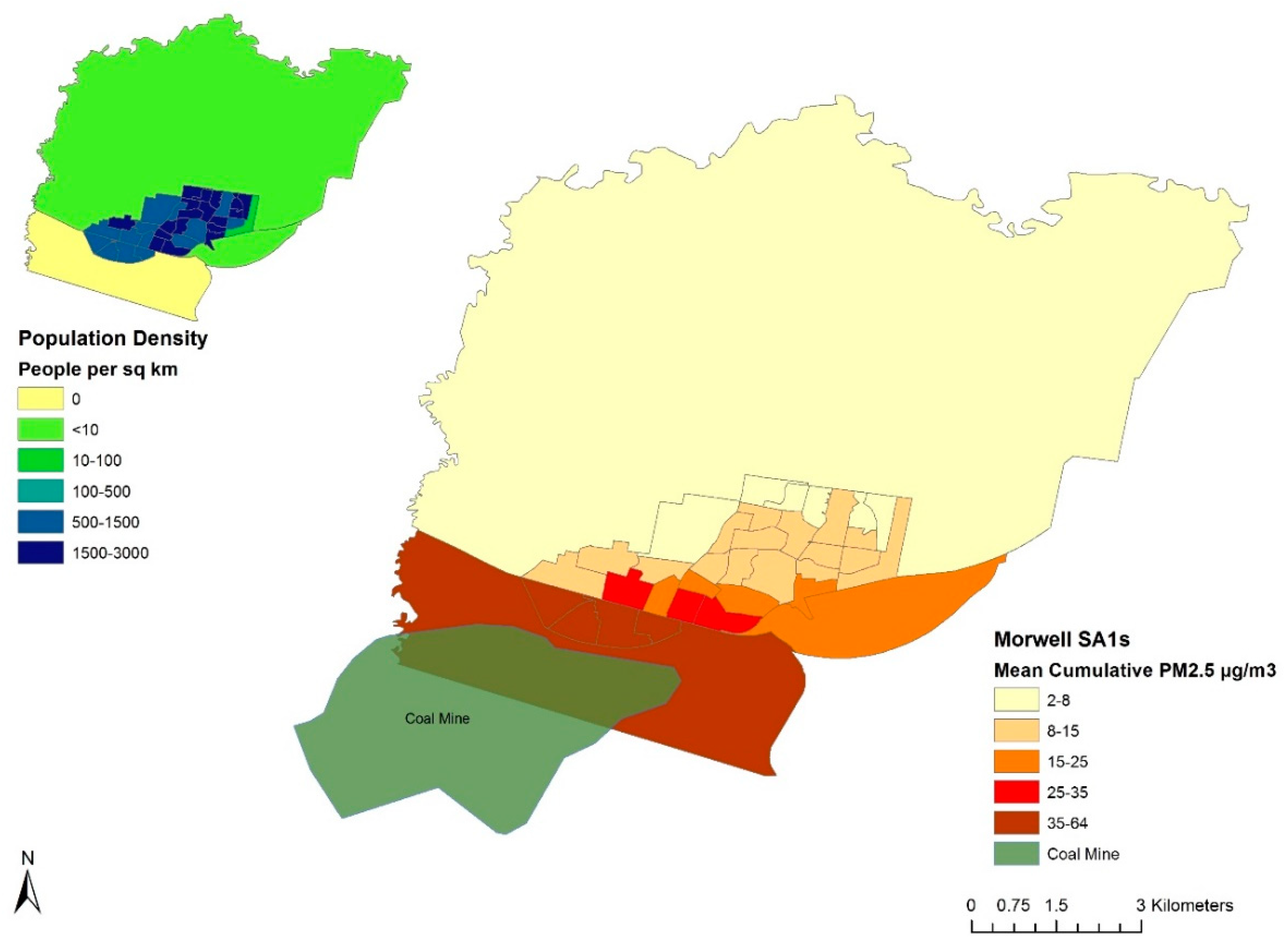
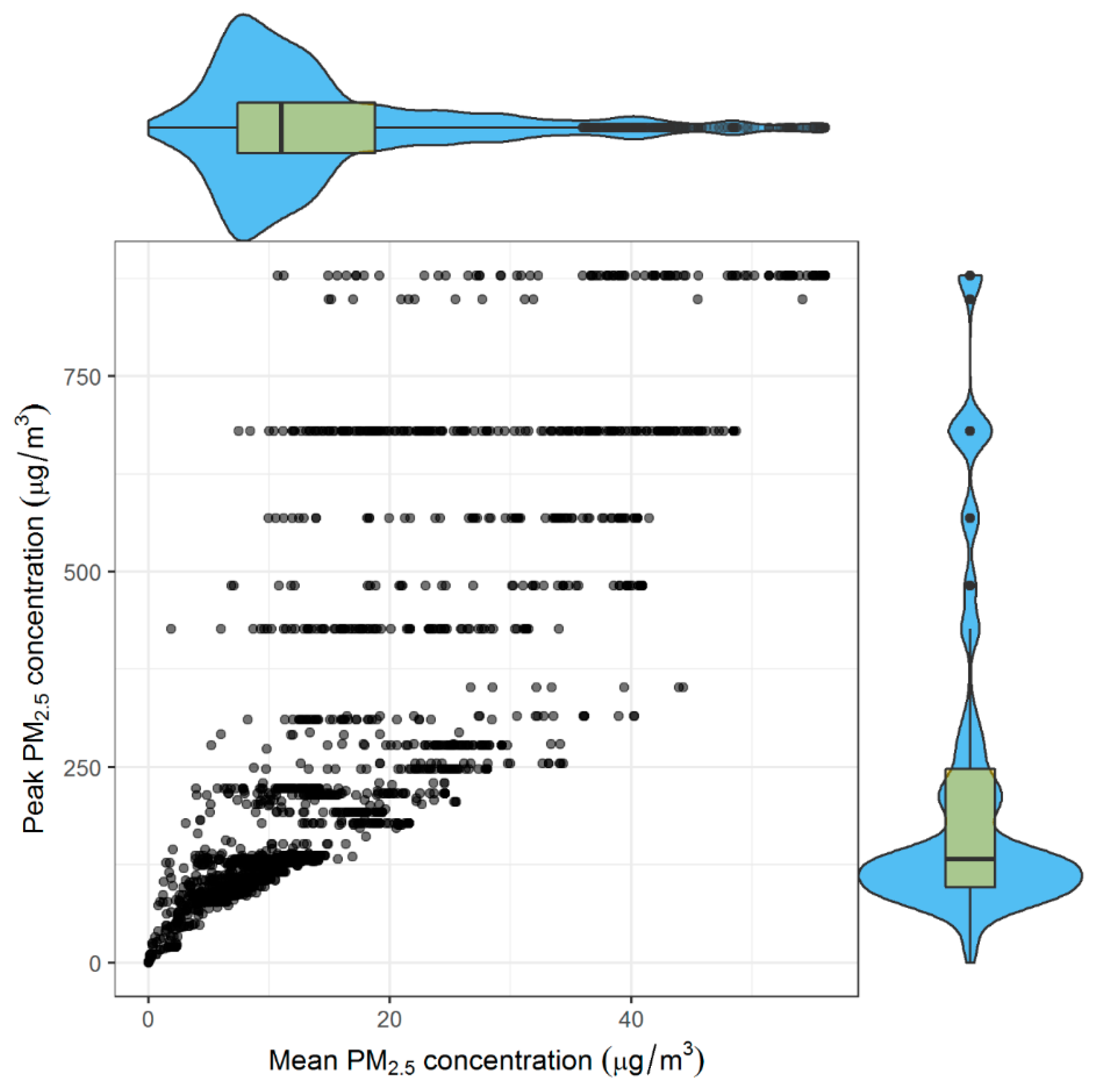
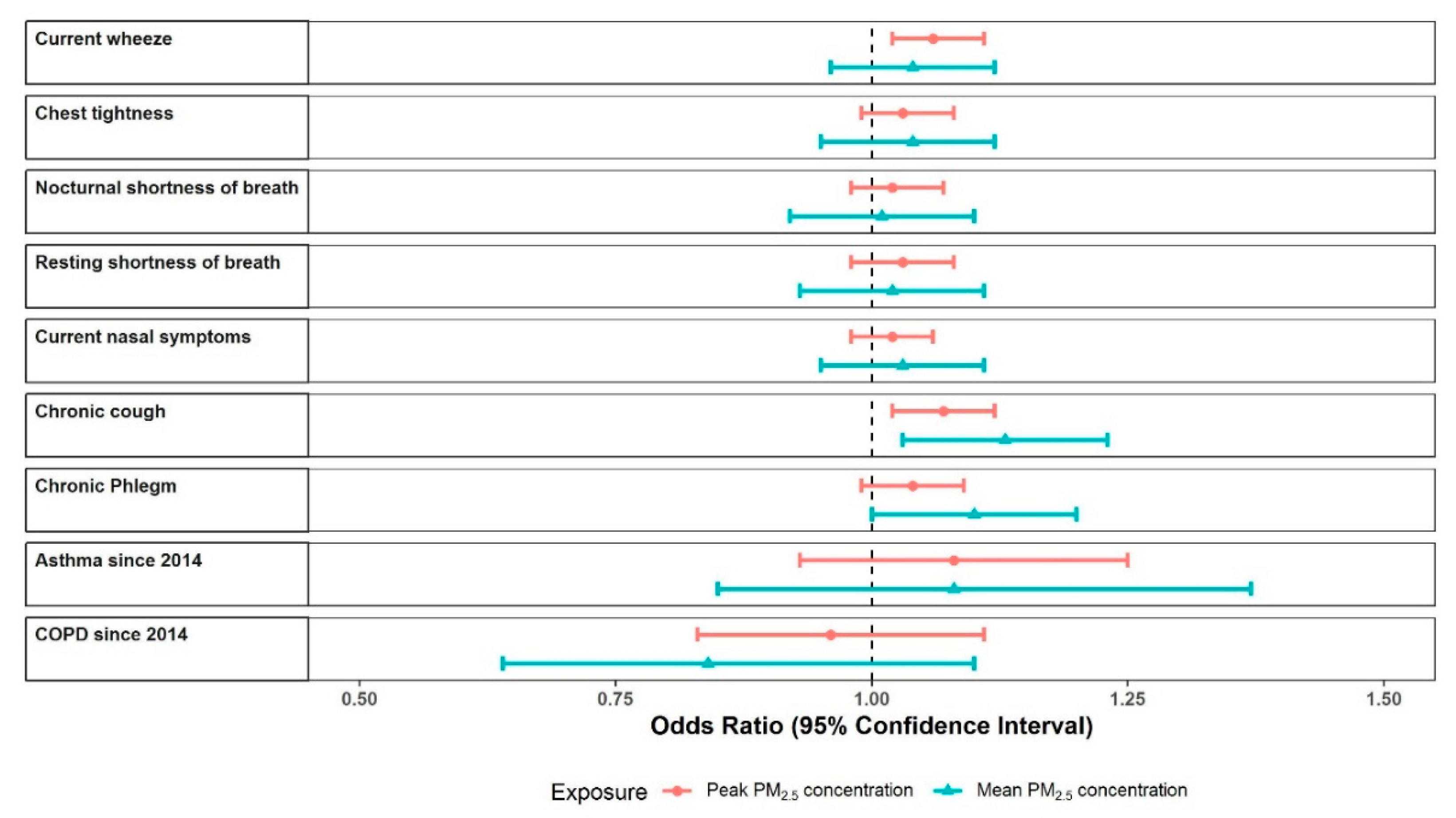
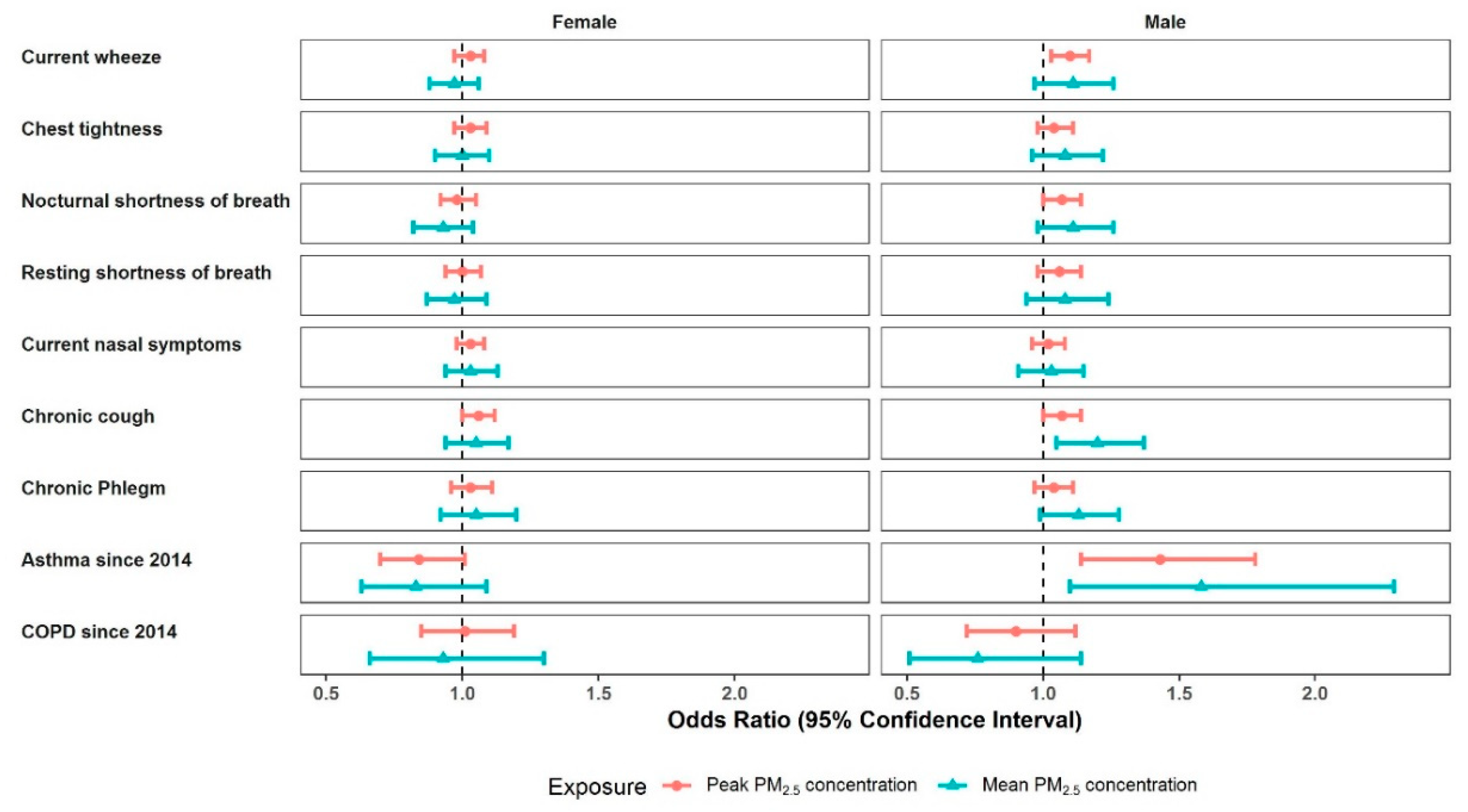
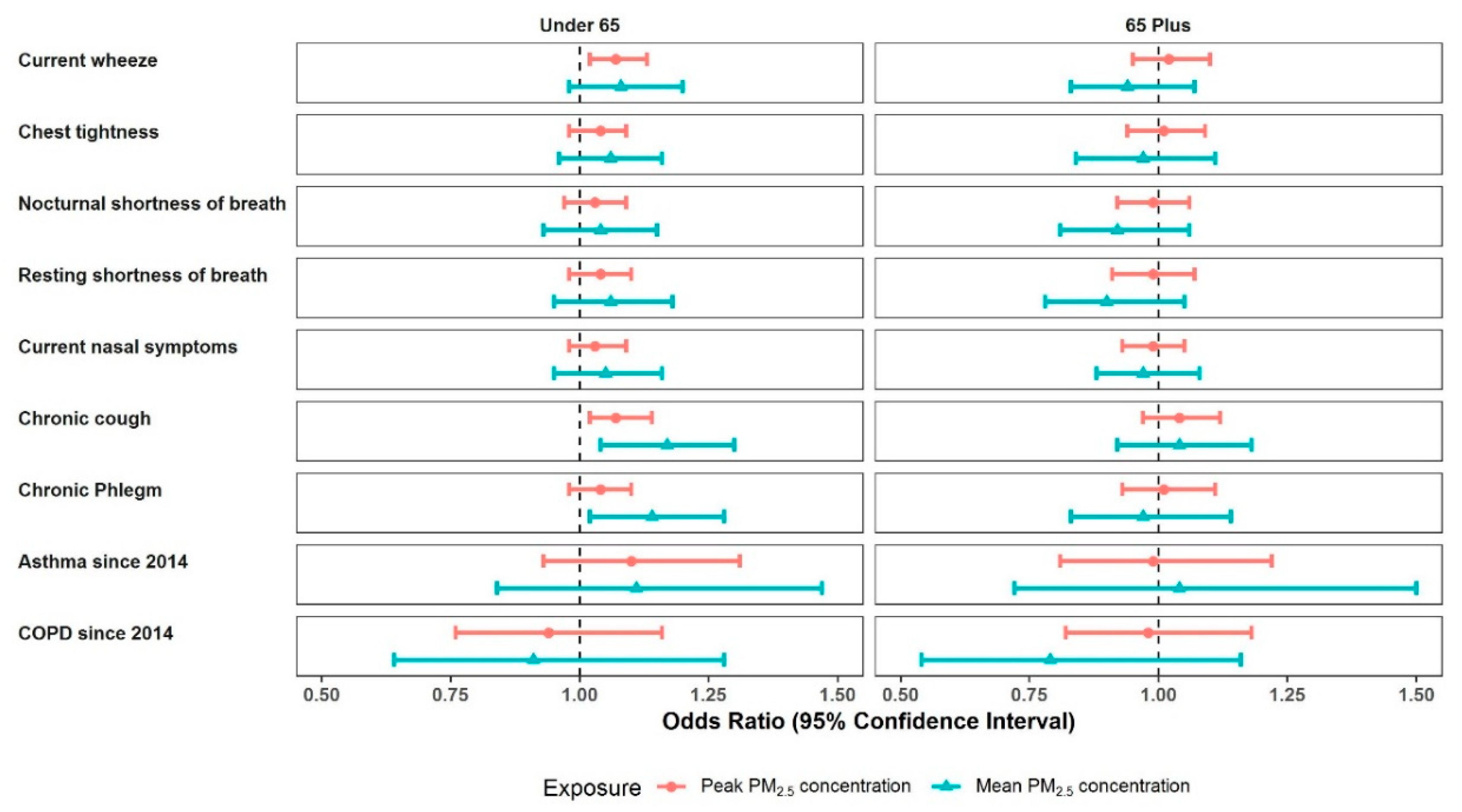
| Predictor Variables | Total | Low Exposure | Medium Exposure | High Exposure | p-Value * |
|---|---|---|---|---|---|
| Weighted Mean (SD) | Weighted Mean (SD) | Weighted Mean (SD) | Weighted Mean (SD) | ||
| Age during the mine-fire | 48.07 (18.59) | 47.71 (18.68) | 46.69 (17.88) | 49.78 (19.05) | 0.020 |
| n (weighted %) | n (weighted %) | n (weighted %) | n (weighted %) | p-value * | |
| Male | 1389 (48%) | 447 (47%) | 461 (50%) | 481 (47%) | 0.371 |
| Employment | 0.337 | ||||
| Paid employment (FT, PT, self-employed) | 1311 (51%) | 428 (52%) | 441 (53%) | 442 (50%) | |
| Other (student/volunteer/home-duties/retired) | 1368 (35%) | 464 (36%) | 430 (33%) | 474 (37%) | |
| Unemployed | 139 (6%) | 50 (6%) | 48 (7%) | 41 (5%) | |
| Not working due to ill-health | 239 (7%) | 67 (6%) | 82 (7%) | 90 (8%) | |
| Highest educational qualification | 0.082 | ||||
| Secondary up to year 10 | 1006 (27%) | 317 (26%) | 357 (29%) | 332 (26%) | |
| Secondary year 11–12 | 668 (24%) | 203 (22%) | 236 (27%) | 229 (23%) | |
| Certificate (trade/apprenticeship/technicians) | 996 (34%) | 355 (35%) | 291 (32%) | 350 (35%) | |
| University or other Tertiary Institute degree | 385 (15%) | 136 (17%) | 113 (12%) | 136 (15%) | |
| Married/Defacto | 1852 (57%) | 676 (61%) | 601 (56%) | 575 (54%) | 0.019 |
| Smoking status | 0.027 | ||||
| Never | 1495 (51%) | 516 (54%) | 493 (52%) | 486 (47%) | |
| Former smoker | 1052 (31%) | 356 (30%) | 328 (29%) | 368 (33%) | |
| Current smoker | 516 (18%) | 141 (15%) | 183 (19%) | 192 (20%) | |
| Work exposure | 0.098 | ||||
| Not exposed | 1825 (62%) | 620 (64%) | 611 (64%) | 594 (59%) | |
| Coal mine/station exposed | 494 (14%) | 162 (13%) | 147 (12%) | 185 (16%) | |
| Exposed, but not coal mine/station | 777 (24%) | 244 (22%) | 254 (24%) | 279 (25%) | |
| Roof main material—iron/tin | 977 (32%) | 231 (24%) | 346 (34%) | 400 (37%) | <0.001 |
| Home main material—concrete/brick | 1927 (61%) | 774 (76%) | 606 (58%) | 547 (51%) | <0.001 |
| Asthma pre 2014 | 715 (26%) | 248 (27%) | 238 (26%) | 229 (24%) | 0.259 |
| COPD pre 2014 | 148 (4%) | 44 (3%) | 45 (3%) | 59 (4%) | 0.379 |
| Outcome Variables | Total | Low Exposure | Medium Exposure | High Exposure | p-Value * |
|---|---|---|---|---|---|
| n (Weighted %) | n (Weighted %) | n (Weighted %) | n (Weighted %) | ||
| Current wheeze | 1317 (42%) | 422 (41%) | 418 (40%) | 477 (46%) | 0.021 |
| Chest tightness | 792 (27%) | 237 (25%) | 265 (27%) | 290 (29%) | 0.201 |
| Nocturnal shortness of breath | 635 (20%) | 203 (20%) | 207 (19%) | 225 (21%) | 0.604 |
| Resting shortness of breath | 611 (20%) | 194 (19%) | 197 (20%) | 220 (22%) | 0.397 |
| Current nasal symptoms | 1358 (44%) | 445 (44%) | 425 (41%) | 488 (47%) | 0.114 |
| Chronic cough | 989 (31%) | 296 (26%) | 340 (32%) | 353 (34%) | 0.004 |
| Chronic phlegm | 785 (25%) | 242 (23%) | 259 (25%) | 284 (27%) | 0.133 |
| Asthma since 2014 | 59 (2%) | 21 (2%) | 18 (2%) | 20 (2%) | 0.722 |
| COPD since 2014 | 60 (1%) | 21 (1%) | 20 (2%) | 19 (1%) | 0.984 |
© 2019 by the authors. Licensee MDPI, Basel, Switzerland. This article is an open access article distributed under the terms and conditions of the Creative Commons Attribution (CC BY) license (http://creativecommons.org/licenses/by/4.0/).
Share and Cite
Johnson, A.L.; Gao, C.X.; Dennekamp, M.; Williamson, G.J.; Brown, D.; Carroll, M.T.C.; Ikin, J.F.; Del Monaco, A.; Abramson, M.J.; Guo, Y. Associations between Respiratory Health Outcomes and Coal Mine Fire PM2.5 Smoke Exposure: A Cross-Sectional Study. Int. J. Environ. Res. Public Health 2019, 16, 4262. https://doi.org/10.3390/ijerph16214262
Johnson AL, Gao CX, Dennekamp M, Williamson GJ, Brown D, Carroll MTC, Ikin JF, Del Monaco A, Abramson MJ, Guo Y. Associations between Respiratory Health Outcomes and Coal Mine Fire PM2.5 Smoke Exposure: A Cross-Sectional Study. International Journal of Environmental Research and Public Health. 2019; 16(21):4262. https://doi.org/10.3390/ijerph16214262
Chicago/Turabian StyleJohnson, Amanda L., Caroline X. Gao, Martine Dennekamp, Grant J. Williamson, David Brown, Matthew T. C. Carroll, Jillian F. Ikin, Anthony Del Monaco, Michael J. Abramson, and Yuming Guo. 2019. "Associations between Respiratory Health Outcomes and Coal Mine Fire PM2.5 Smoke Exposure: A Cross-Sectional Study" International Journal of Environmental Research and Public Health 16, no. 21: 4262. https://doi.org/10.3390/ijerph16214262
APA StyleJohnson, A. L., Gao, C. X., Dennekamp, M., Williamson, G. J., Brown, D., Carroll, M. T. C., Ikin, J. F., Del Monaco, A., Abramson, M. J., & Guo, Y. (2019). Associations between Respiratory Health Outcomes and Coal Mine Fire PM2.5 Smoke Exposure: A Cross-Sectional Study. International Journal of Environmental Research and Public Health, 16(21), 4262. https://doi.org/10.3390/ijerph16214262








